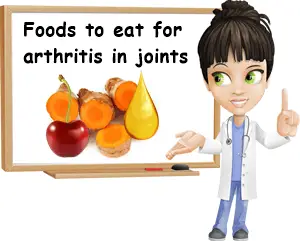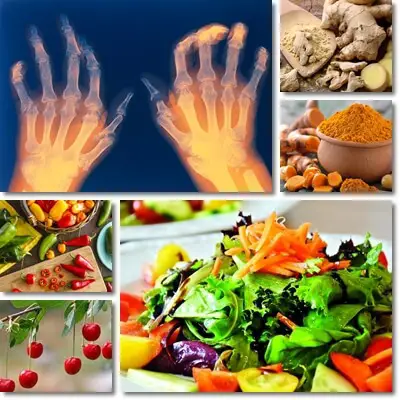Knowing what the best foods to eat and to avoid for arthritis are can help reduce joint inflammation and pain, improve mobility and increase life quality. The best foods to eat for arthritis are the foods with superior anti-inflammatory properties and a dense nutritional profile such as turmeric, ginger, cherries or fish rich in Omega-3 fatty acids. Sufferers need a wide range of natural anti-inflammatory foods as well as important dietary sources of all essential vitamins and dietary minerals for arthritis pain relief and treatment.
What is arthritis? By definition, arthritis is a condition that causes joint inflammation and pain. Joints often become red, visibly swollen and rigid. Over time, as the cartilage connecting two bones gradually wears away, there is more loss of mobility and bones may become deformed. Bone deformities occur mostly in cases of arthritis in hands and arthritis in feet where the fingers and toes become curved, grow nodules and overlap each other. Arthritis in knees, hips or spine may require surgery for correction. Depending on the causes behind the condition and the type of arthritis, other organs or systems may be affected.

What is the best arthritis-friendly diet? Arthritis is basically caused by inflammation (read more about arthritis). And inflammation in the body can be managed or reduced by what we eat, irrespective of its triggering factor. Various natural compounds occurring in foods of all sorts have varying levels of anti-inflammatory action and can actively contribute to reducing inflammation levels in the body. This means that what we eat can actually relieve arthritis pain and reduce swelling to a certain extent. So what to eat and what to avoid for arthritis pain and treatment?
Best foods for arthritis
1) Kakadu plum. The green plum, billygoat plum or Kakadu plum provides anywhere from 2,300 to over 5,000 mg of vitamin C per 100 g of fruit. This astonishing amount makes it by far the best source of the anti-inflammatory nutrient and a great food for arthritis sufferers. Read more about the benefits of the Kakadu plum.
2) Camu camu. Camu camu is a highly sour and acidic fruit, but incredibly rich in vitamin C, probably the strongest and most efficient natural anti-inflammatory compound. 100 g of camu camu contains anywhere between 1,800-2,500 mg of vitamin C, an extraordinary amount. The fruit is one of the best foods for arthritis inflammation and pain management. It also contains potent antioxidants such as anthocyanins, flavonoids, gallic acid, ellagic acid and rutin, further contributing to its anti-inflammatory and immune-boosting benefits. Read more about the benefits of camu camu.

3) Acerola cherry. Acerola cherries are good for arthritis pain because of their incredibly high content of vitamin C: around 1,600 mg per 100 g of fruit. Their red color is also indicative of other antioxidant compounds such as carotenoids and flavonoids. Antioxidants are known to exert a strong anti-inflammatory action, reducing inflammation levels in the body and thus helping manage painful inflammatory conditions like arthritis.
4) Cherries and tart cherries. Both sweet cherries and sour cherries have been shown to reduce inflammation levels in the body and actively contribute to managing arthritis pain. Sufferers report feeling better soon after eating a handful of either sweet or sour cherries or drinking cherry or sour cherry juice. Osteoarthritis sufferers given 400 mg of sour cherry extract for 3 months reported a visible improvement of joint mobility and reduction in pain. Sweet cherries and tart cherries for arthritis indeed seem to be a valid natural remedy with visible benefits both in the short and long term.
5) Turmeric and ginger. Turmeric and ginger are two related spices and strong anti-inflammatory foods. Both contain unique anti-inflammatory compounds that reduce swelling, helping manage inflammatory conditions such as arthritis. Turmeric contains curcumin, fresh ginger contains gingerol, while cooked ginger contains shogaols and zingerone, all four compounds that give the spices their unique pungency and beneficial anti-inflammatory, antioxidant and anticancer properties. Eating turmeric has been reported to reduce neck osteoarthritis pain in particular, but both spices hold important antiarthritic properties, reducing swelling and pain.
6) Hot peppers. Hot peppers contain capsaicin, a compound giving them pungency as well as anti-inflammatory effects. Studies show capsaicin has strong analgesic properties, which would explain the pain relief arthritis sufferers experience after consuming hot peppers. The pain-relieving effects of the compound are comparable to those of regular medication. Capsaicin is chemically related to gingerol in ginger and piperine in pepper, hence their similar therapeutic action.
7) Leaf vegetables. Spinach, broccoli, dandelion greens, romaine lettuce, kale, Swiss chard, Brussels sprouts, cabbage, collards, turnip greens and other leaf vegetables are especially rich in vitamin K, a nutrient with important anti-inflammatory properties and benefits for several types of arthritis. Leaf vegetables like these also provide important amounts of antioxidants such as vitamins A and C, helping counteract free radical damage and prevent and manage arthritis. The good amounts of calcium in the vegetables further contribute to bone health.
A special organosulfur compound in cruciferous vegetables called sulforaphane has been shown to inhibit the production of enzymes that cause cartilage loss and joint damage. The compound is found in generous amounts in broccoli, but also in other cruciferous and leaf vegetables and may play a vital role in preventing and slowing down arthritis.
8) Omega-3 rich foods. Omega-3 fatty acids from both plant and animal sources exert strong anti-inflammatory properties and reduce free radical damage, potentially improving arthritis pain. Nuts, seeds and cold-pressed vegetable oils are the preferred sources for plant form of Omega-3 (ALA), while fish and fish oils, algae of seaweed are the preferred sources for the healthy EPA and DHA forms of Omega-3.
Worst foods for arthritis
What foods to avoid for arthritis? All forms of processed food, heavy, fatty or fried foods, baked goods or pastry rich in refined flour, sugar and unhealthy fats, candy or excess sugar, alcohol and smoking are all to be avoided if you suffer from any type of arthritis or joint pain. However, there several other foods which are not 100% bad for arthritis, but which some people report have worsened their joint swelling and pain. Below is a list of foods arthritis sufferers say are bad for the condition:
1) Tomatoes.
2) Eggplants.
3) Potatoes.
4) Rhubarb.
5) Coffee.
6) Hot peppers.
7) Dairy.
Some of these foods have been shown to have both health benefits and health risks. For example, coffee is a great antioxidant. At the same time, it can trigger inflammation and causes nutritional deficiencies. Some studies have shown the antioxidant effects of red wine, but alcohol in general is proven to be bad for health. Similarly, some people report tomatoes worsen their joint pain and excluding them from their diet leads to a visible improvement of symptoms. The same is true for eggplants and potatoes from the same family as tomatoes which some sufferers find best to avoid.
These may very well be well-grounded observations hiding scientific truths or simply effects of one’s strong beliefs like a placebo effect. In any case, if a food seems to be worsening arthritis pain and swelling, it might be best to look for alternatives. If it’s good for you and it makes you feel better, like drinking sweet cherry or sour cherry juice, then why not keep it up and enjoy the benefits further. Because, in some respects, health is very personal and what may be good for some people, is not necessarily just as good or good at all for others. The same is true for disorders like arthritis and the foods to eat and the foods to avoid for the joint pain and swelling it causes.
